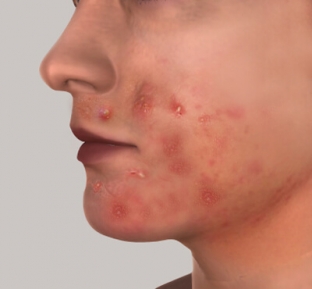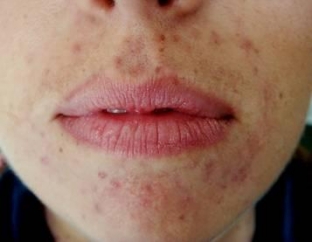The causes of perioral dermatitis are not fully known, however, according to many researchers, this disease is of a bacterial nature and is associated with congenital features of the epidermis. It can be triggered by the use of certain medications and hormonal disruptions, aggravated by the use of fluoridated toothpastes and certain types of facial cosmetics. What is perioral dermatitis, and what are its manifestations, read further on estet-portal.com.
What factors provoke the development of perioral dermatitis?
 Perioral dermatitis (PD; synonyms: dermatitis perioralis, steroid facial dermatitis, perioral rosacea, rosacea-like dermatitis, perioral allergic dermatitis, perioral seborrheic dermatitis, stewardess disease) is a chronic recurrent rosacea-like dermatosis of unknown origin with perioral localization of hemispherical small papules, papulo -vesicles and rarely - papulo-pustule on diffusely inflamed erythematous skin.
Perioral dermatitis (PD; synonyms: dermatitis perioralis, steroid facial dermatitis, perioral rosacea, rosacea-like dermatitis, perioral allergic dermatitis, perioral seborrheic dermatitis, stewardess disease) is a chronic recurrent rosacea-like dermatosis of unknown origin with perioral localization of hemispherical small papules, papulo -vesicles and rarely - papulo-pustule on diffusely inflamed erythematous skin.
Provoking factors of perioral dermatitis are:
- external use of potent glucocorticosteroids (GCS; especially fluorinated);
- use of inhaled corticosteroids;
- use of cosmetics;
- ultraviolet irradiation;
- presence of foci of chronic infection;
- presence of severe infectious diseases;
- hormonal dysfunctions;
- taking contraceptives;
- use of fluoridated toothpastes;
- use in dentistry of amalgam (containing mercury compounds);
- chewing gum use;
- use of various medicinal mixtures intended for rinsing the mouth;
- application of propolis.
The main causes of perioral dermatitis
Fusobacterium is cultured from patients with perioral dermatitis, suggesting a bacterial nature of the disease. The cause of the disease can be a long-term use of various cleansing, moisturizing cosmetics, fluorinated products. Also, PD often occurs in patients suffering from atopic dermatitis.
According to some authors, in most cases, perioral dermatitis is idiopathic, that is, it is not caused by provoking factors, but is associated with a congenital violation of the barrier function of the epidermis and hypersensitivity of the skin.
The incidence is 0.5-1%. Perioral dermatitis occurs in 6% of women and 0.3% of men with dermatological pathology. Read more on estet-portal.com for symptoms of perioral dermatitis. Among all patients suffering from PD, the majority (90%) are women aged 18 to 50 years, sometimes children get sick, less often men.
Clinical manifestations and symptoms of perioral dermatitis
In the initial period of perioral dermatitis, papules and pustules appear against the background of erythema. First, small papules (1–2 mm in diameter) appear against the background of hyperemic spots. Later, the papules become much larger, they merge into plaques, surrounded on the periphery by child elements - papules, vesicles or pustules. The plaques are red, scaly. There are no comedones. Telangiectasias on the skin are rare.
 Localization. The first rashes, as a rule, are noted around the mouth. The narrow rim around the red border of the lips remains unaffected. Small papules (1-2 mm) and pustules may appear around the eyes (occasionally - only around the eyes). Sometimes the forehead and glabella, nasolabial area are affected. Children usually have perioral dermatitis with or without perinasal and/or periocular localization.
Localization. The first rashes, as a rule, are noted around the mouth. The narrow rim around the red border of the lips remains unaffected. Small papules (1-2 mm) and pustules may appear around the eyes (occasionally - only around the eyes). Sometimes the forehead and glabella, nasolabial area are affected. Children usually have perioral dermatitis with or without perinasal and/or periocular localization.
Subjectively, during periods of exacerbations, patients with perioral dermatitis feel a slight burning sensation and itching, a feeling of tightness of the skin. Often there is an increase in discomfort and hyperemia after ingestion of hot food, alcoholic beverages, changes in air temperature and weather conditions (cold, heat, wind, sun).
The rashes appear gradually over several weeks or months. Without treatment, PD lasts for months and years, subsiding and aggravating. Relapses are not excluded even with proper treatment. What drugs are used to treat perioral dermatitis, read in our next article.






Add a comment